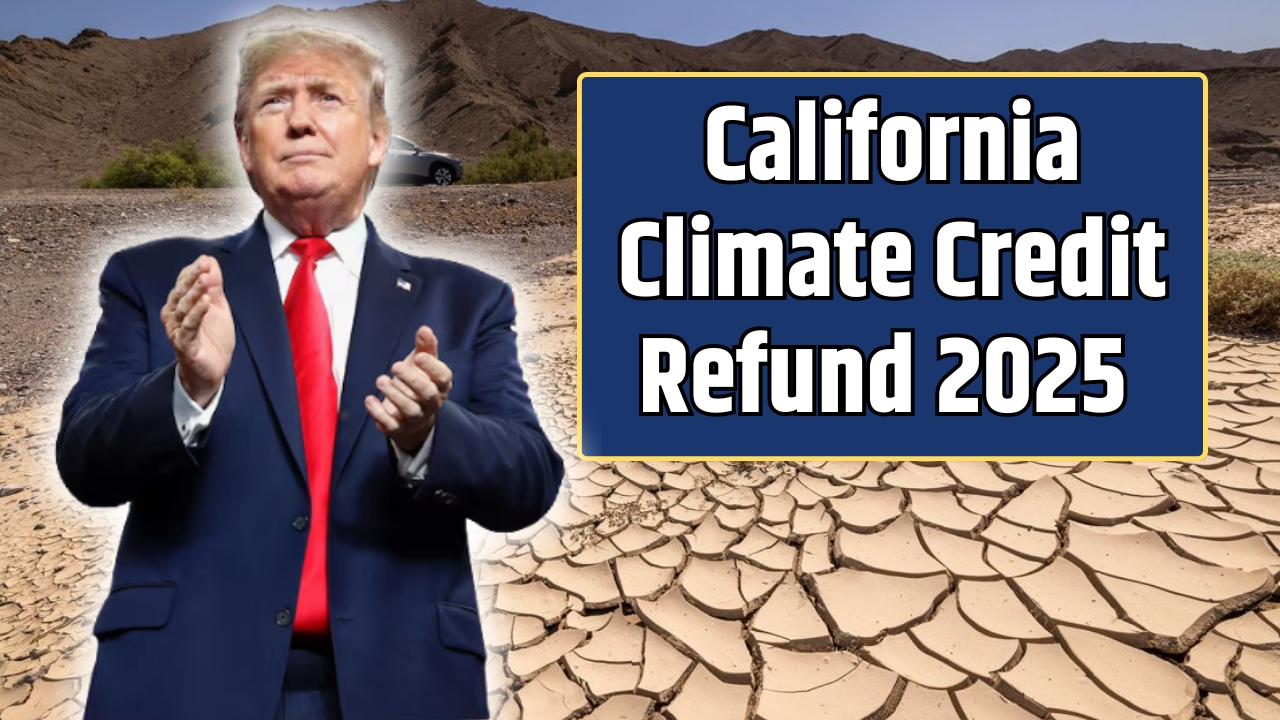Join on WhatsApp
Get the latest updates directly on WhatsApp – motivation, news & more!
Californians are once again seeing a climate dividend show up right on their utility bills. Starting October 2025, millions of residents will receive the California Climate Credit Refund, a twice-a-year payment that returns part of the state’s carbon cap-and-trade revenue directly to households and small businesses. Depending on your utility provider, the California Climate Credit Refund 2025 ranges from $34.91 to $259.36, with most residential customers getting an average refund between $56 and $81 this fall.
The idea is simple: polluters pay, consumers benefit. The credit comes automatically as a line item on your power bill—no paperwork, no application. And while the amounts might look modest, the total value of these credits is enormous: over $700 million to residential customers and another $60 million earmarked for small businesses.
California Climate Credit Refund 2025: How It Works
The refund is part of California’s Cap-and-Trade Program, a policy that requires large industrial polluters to buy permits for the greenhouse gases they emit. Those auction proceeds—billions collected each year—are then distributed in several ways, including infrastructure, renewable energy projects, and these direct household credits.
| Program Name | California Climate Credit Refund 2025 |
|---|---|
| State | California |
| Year | 2025 |
| Managed By | California Public Utilities Commission (CPUC) |
| Funding Source | Cap-and-Trade Program (Greenhouse Gas Allowance Auctions) |
| Average Residential Credit | $56 – $81 |
| Range of Payments | $34.91 – $259.36 |
| Distribution | Automatically via electricity and gas bills |
| Official Website | https://www.cpuc.ca.gov/climatecredit/ |
The California Climate Credit is meant to demonstrate that strong environmental policies can deliver financial benefits to ordinary Californians—not just costs. It’s a way for the state to redistribute climate revenues equitably while encouraging the transition to cleaner energy.
Who Qualifies for the 2025 Climate Credit
Almost everyone with a residential utility account qualifies. You don’t have to sign up or file a form. The credit is applied automatically to your electricity bill (and once annually for gas customers).
Eligibility Highlights
- All residential electricity customers of the major utilities:
- Pacific Gas & Electric (PG&E)
- Southern California Edison (SCE)
- San Diego Gas & Electric (SDG&E)
- Pacific Power
- Natural gas customers also receive a credit, but only once per year in April.
- Small businesses, schools, and nonprofits that use eligible commercial accounts also qualify.
- Even households with solar panels or net metering still receive the credit through their utility account.
Essentially, if you get an electric bill from one of California’s investor-owned utilities, you qualify.
Why the Credit Matters
Electricity costs in California have climbed steadily in recent years, with higher transmission costs and infrastructure upgrades driving rates up. The October credit comes at a crucial moment—right before winter, when heating and lighting costs spike.
The CPUC intentionally times the fall distribution to ease household expenses just as the year-end utility bills rise.
“This isn’t just an environmental policy,” said a CPUC spokesperson in a recent press briefing. “It’s a financial one. The Climate Credit returns value to consumers while holding major emitters accountable for pollution costs.”
By redistributing these funds, California shows that climate regulations can deliver tangible household benefits rather than just penalties for polluters.
Climate Credit Payouts by Utility (2025)
The size of your refund depends entirely on which utility serves your home or business. The major investor-owned utilities will apply the following credits directly to customer bills.
| Utility Provider | April 2025 Credit | October 2025 Credit | Total Annual Credit (2025) |
|---|---|---|---|
| Pacific Gas & Electric (PG&E) | $58.23 | $58.23 | $116.46 |
| Southern California Edison (SCE) | $56.00 | $56.00 | $112.00 |
| San Diego Gas & Electric (SDG&E) | $81.38 | $81.38 | $162.76 |
| Pacific Power | $259.36 | $259.36 | $518.72 |
| Liberty Utilities / Bear Valley | ~$40 | ~$40 | $80.00 (approx.) |
For natural gas users, the credit is smaller and delivered once annually in April, typically between $34.91 and $50, depending on your provider.
When You’ll Receive the Credit
The California Climate Credit appears automatically on your utility statement twice a year — April and October — for electric customers. For 2025, the key dates are:
| Customer Type | Next Credit Date | Distribution Method |
|---|---|---|
| Electric (PG&E, SCE, SDG&E, etc.) | October 2025 | Automatically on electricity bill |
| Natural Gas Users | April 2025 (already issued) | Automatically on gas bill |
No need to call your utility or sign up — it happens automatically. If you’re on autopay, you might not even notice unless you check your billing breakdown.
The Environmental and Economic Impact
This program reflects California’s effort to make climate action economically inclusive. Rather than charging households directly for carbon emissions, the state’s Cap-and-Trade system places the cost burden on major emitters — refineries, power plants, and industrial operations. Those funds are then redistributed:
- 80% goes to residential and small-business bill credits.
- 20% supports statewide clean-energy and efficiency projects.
Since its launch in 2014, the Climate Credit has returned billions to consumers while supporting California’s goal of reaching net-zero greenhouse gas emissions by 2045.
Benefits of the California Climate Credit
- Automatic Financial Relief: No paperwork or registration — the credit is applied directly to bills.
- Promotes Energy Equity: Helps offset rising electricity and gas prices, especially for low- and moderate-income families.
- Supports Climate Goals: Funded by polluters under the Cap-and-Trade system.
- Twice-Yearly Timing: April (spring) and October (fall) credits strategically help households before high-usage seasons.
- Encourages Public Buy-In: Makes climate policy visible and tangible for everyday Californians.
What to Do If You Don’t See the Credit
If you’re eligible but don’t see the California Climate Credit on your October or April bill:
- Check whether your utility account is active and in your name.
- Contact your utility provider’s customer service for assistance.
- Visit https://www.cpuc.ca.gov/climatecredit/ for FAQs and utility-specific contact links.
The CPUC typically requires all major utilities to issue the credit during the same month, but small municipal or community-owned utilities may have separate schedules.
Fact Check: Is the California Climate Credit a Refund or Stimulus?
Claim: The California Climate Credit is a stimulus check or special state refund.
Fact: False. It is not a direct cash payment or stimulus, but rather a bill credit funded by cap-and-trade revenue. The amount varies by utility and is applied automatically to reduce your energy charges.
You won’t receive it as a bank deposit or paper check — it shows up directly as a line item on your energy bill labeled “California Climate Credit.”
FAQs
Who qualifies for the 2025 Climate Credit?
All residential customers of participating utilities, including those with solar or community energy programs.
How often is the credit issued?
Twice a year for electric customers (April and October), and once annually for natural gas users (April).
Do I need to apply for it?
No. It’s automatically applied to your bill.
How much is the 2025 Climate Credit?
Between $34.91 and $259.36, depending on your utility provider.
What if I move or switch utilities?
You’ll receive the credit from whichever provider your account is active with at the time of distribution.




